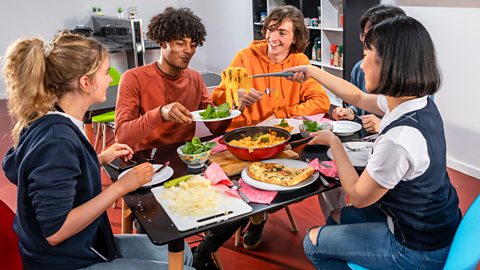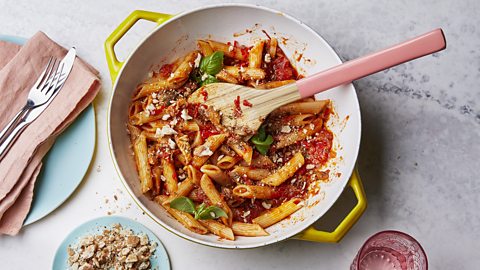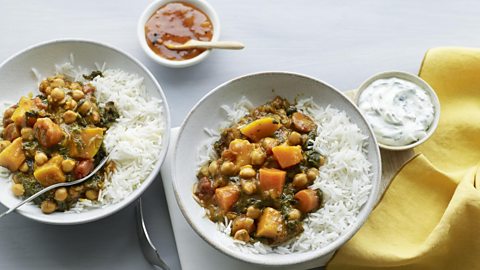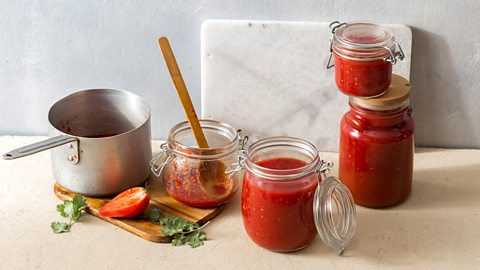A student guide to saving money on food
If you’re going to university this year and concerned about how you’ll afford your food shop, there are ways to cut costs, says Fliss Freeborn

Sky-high rents and rocketing household bills mean the university population in the UK is struggling financially, with more than three-quarters (78%) of students concerned that the rising cost of living may affect how well they do in their studies.
While the issues are clearly systemic, students have been left grappling with their financial situations individually, looking for more ways to cut down on personal spending to help mitigate the problem. Reducing food costs is one always of the most talked about ways of cutting household bills. But it’s usually more complex – and more personal – than doing the obvious things like buying supermarket value ranges and swapping out meat for legumes.
Really, budgeting starts well before you step foot in a supermarket and the journey involves a lot of trial and error, especially if you’re cooking and eating away from home for the first time.
As a student, I had to drastically cut food costs and became so passionate about it I started my own food blog, and have even published a book for young people on how to make cheap and easy meals.
So, to help you get started on the right foot and save you from sorting through the endless advice about meal planning, takeaways and batch cooking that you can find online, here are some practical pointers to keep yourself fed cheaply and healthily at university.
Cook from scratch (or learn to)
Cooking is the cheapest way of feeding yourself (yes, even with those 2-for-1 pizza leaflets that keep landing on the doormat), not to mention the best way to keep healthy. Choosing convenience over effort on a regular basis can have its costs – both for your bank account and your body. Save ordering in for special occasions.
If you don’t really know your way around the kitchen yet, that’s OK – but it’s well worth learning. It’s an invaluable life skill and is actually fun once you’ve got the hang of it. Use social media – YouTube, TikTok, Instagram – as well as dedicated food recipe sites, or go the old-fashioned route and find a cookbook full of cheap, healthy options which don’t take much skill.
Share, share and share alike
Sharing’s caring. And it’s cheaper. Split basics like teabags, salt, spices, sugar and washing up liquid with your housemates, as this will cut individual costs and means you can buy in bulk which is often cheaper. If it’s practical and you go through them at a similar rate, you could also consider sharing big, catering-size bags of rice or pasta.
The same goes for squash, milk, jam and, really, anything else you find you’re duplicating unnecessarily. Doing this not only saves money and fridge space, but it also fosters a sense of community while away from home, which is essential for when times get tough.
Pasta with spicy sardine and tomato sauce and crispy pitta breadcrumbs
Use up that big bag of pasta by making this budget dish which is full of flavour

The one thing that truly cements that sense of community, though, is eating together. Splitting some of the cooking, if only once a week, is an amazing way of forming bonds with your housemates and course friends. There’s nothing nicer than sitting down to a meal together that you’ve all helped to make.
A fun idea is for everyone to take it in turns to cook something they grew up eating. Failing that, really easy, budget-friendly and crowd-pleasing ideas for group cooking could be a lentil curry or a hearty vegetable stew.
Get organised
OK, let’s get to the real nuts and bolts of food budgeting. If you want your food bill to be as low as possible – I’m talking around £20 a week for all 21 meals while maintaining a balanced diet – you need to be planning everything in advance, relying on lentils and other legumes for most of your protein needs, eating a lot of oats and bananas, avoiding convenience food like jarred sauces and probably batch cooking.
However, cooking like this long term can feel pretty rigid, especially when you consider that food can be a really fun thing to explore and experiment with. In fact, the average student spend on groceries is actually more like £31 a week – a budget that gives a little more flexibility to purchase time-saving, flavour-boosting ingredients like curry pastes and a few more complete (but still affordable) protein options like chicken thighs, silken tofu and frozen fish fillets.
Speedy miso noodles with soft boiled egg
You could add an egg to a noodle dish to increase the protein in your meal

To stop yourself going above that amount, remember that convenience always comes at a price: fajita kits, stir-fry meal deals and oven-ready foods tend to be more expensive and less healthy than cooking everything from scratch. So rather than making them the norm, just see them as occasional easy options.
When you first start cooking for yourself, it’s all about trial and error. During my first few months at uni, I realised I hated batch cooking. Because I had the time and the enthusiasm to cook more spontaneously, I switched instead to a modular system of basing my meals around whatever vegetables were on offer and which protein was cheapest at the reduced section (on the odd occasion that I found a whole chicken for £1.86 it felt like I’d won the lottery). This worked to save fridge-space too, as it meant I shopped little and often.
I could cook like this for two reasons. Firstly, I studied a mostly self-directed humanities course which allowed me lots of free time. Secondly, I relied on a solid set of store cupboard staples which I replaced as and when. I divided these – essentially anything with a long shelf-life – into four rough categories: carbs, tins, flavours and frozen. For carbs, I kept some variety of pasta, rice, noodles, couscous and flour (for pastry and bread) in the cupboard. Tins meant tomatoes, chickpeas, coconut milk and different types of beans, as well as dried lentils. In the freezer, I kept fish fingers, frozen peas, mixed berries and green beans.
Spinach and coconut dal
This great budget recipe uses dried red lentils which don’t require soaking in advance of use

My flatmates and I shared flavourings like soy sauce, dried herbs and spices, oils, vinegars, hot sauce, mayonnaise, honey, ketchup and mustard.
I built up these staples slowly – adding to it as and when I could afford to.
Pick your kitchen kit wisely
Deciding which kitchen gadgets will be most useful can be tricky – some are not worth the price tag, while others will almost end up paying for themselves.
Having had shared use of an expensive blender in halls, when I moved out I bought a cheap three-in-one electric chopper. It had a mini blender attachment (for chopping onions and making smoothies), an immersion blender attachment (for soup and curry pastes) and a balloon whisk (for, well, whisking). I still use this now, nearly every time I cook.
I had adverse childhood experiences with slow cookers (mostly involving soggy pasta), but my flatmates used one for energy-saving cooking and it was an effective way to cook hearty meals without much effort.
Veggie slow cooker curry
If there’s a slow cooker in your accommodation, you could use it to make a cheap and easy curry

However, the best energy-saving device which can slot into most people’s lives easily is a microwave, which most student flats come equipped with. This is not only useful for making porridge and reheating leftovers, but also for pre-cooking root veg like potatoes and carrots to save on oven time, melting chocolate, steaming vegetables like broccoli and peas, and making healthy homemade popcorn. I use mine for very quick soups (soften veg for a few minutes, mix with hot stock and blend), although it is perfectly possible to make whole meals in there.
Microwave jacket potatoes with various toppings
You don’t have to turn the oven on to make a jacket potato – use the microwave instead

If you eat a lot of oven food like dippers and chips, or really like your post-gym broccoli and chicken, then using an air fryer could potentially save you money in the long run. However, counter space is usually at a premium in student halls and house shares, so don’t take one with you if you’ve never used it – likewise with rice cookers, slow cookers, or anything else that promises to save energy, but takes up valuable room. Only buy one, or ask for one as a gift, if you know you’re going to use it every day.
Originally published September 2023



